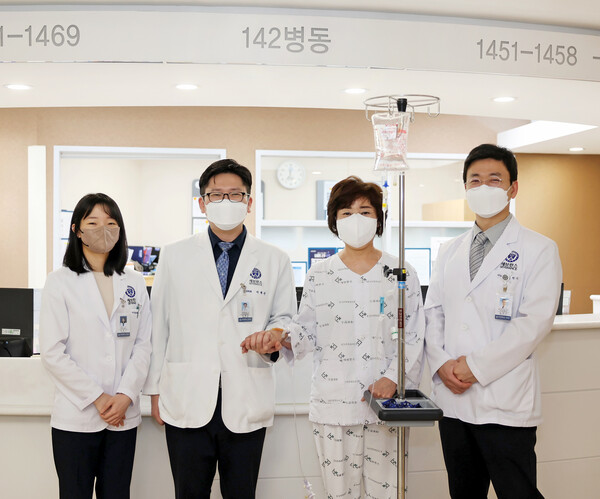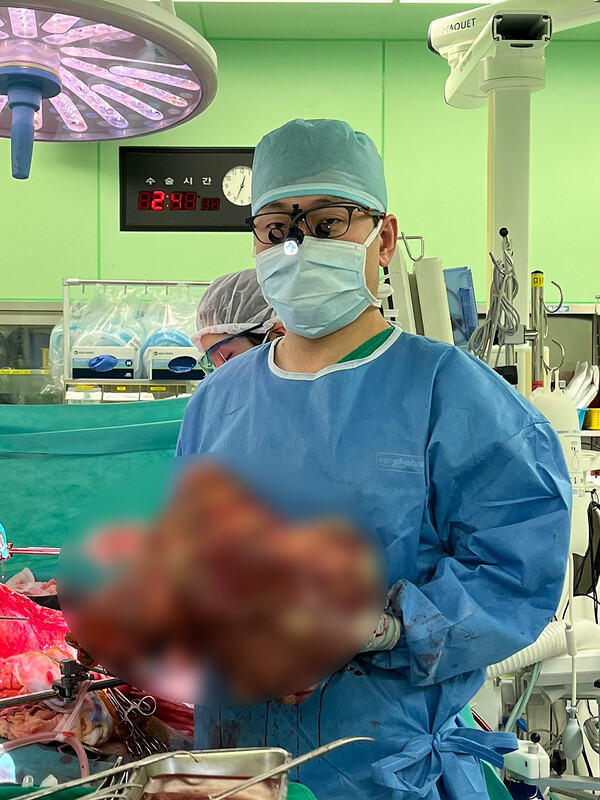A patient diagnosed with cystic liver disease, whose liver exceeded 10 times (12.1 kilograms) the average weight of a healthy liver, recently underwent a triumphant transplant procedure and has since made a remarkable recovery, Severance Hospital said.
Professor Lee Jae-geun at the liver transplantation team of Severance Hospital Transplantation Center said he successfully performed a living donor liver transplant surgery for Kim Ok-hee, a 61-year-old female patient diagnosed with cystic liver disease.
The results of the surgery were presented at the HPB Surgery Week 2023, an international conference held at BEXCO in Busan and organized by the Korean Association of Hepato-Biliary-Pancreatic Surgery.

Kim, who was diagnosed with a cyst in the liver more than a decade ago, visited Severance Hospital in 2020 after her condition worsened. Her liver was abnormally enlarged, with a visible protruding belly. She had a bad complexion and was noticeably thin, except for her belly. After some tests, she was diagnosed with polycystic liver disease.
Polycystic liver disease is a rare condition characterized by the accumulation of waste products within the body, leading to the formation of numerous cysts—sometimes exceeding 20—in the liver. As these cysts progressively enlarge, they impede liver function. A healthy adult liver typically weighs between 1.2 and 1.8 kilograms, but in cases of cystic liver disease, the cysts can adhere to the liver and cause its weight to increase by more than tenfold. In severe instances, this condition can result in complications such as ascites, abdominal pain, and vomiting.
In polycystic liver disease, medications are initially employed to shrink the cysts. Cysts can also be directly ruptured or drained to remove fluid. However, if the enlarged cysts start compressing nearby organs, leading to symptoms like breathing difficulties or indigestion, a liver transplant may be required.
Due to the debilitating effects of Kim's enlarged cysts, which impeded her ability to eat and breathe comfortably, the medical team decided to proceed with a liver transplant. However, Kim's condition was critical, and waiting for a deceased donor was not a viable option. In light of this urgency, her children were assessed to determine their eligibility as potential living liver donors.
Kim's son carried the gene for polycystic liver disease, rendering him ineligible as a liver donor. Her daughter was a viable living donor but her blood type did not match.
For the blood-type incompatible liver transplant, the Department of Infectious Diseases and the Department of Diagnostic Laboratory Medicine worked together to administer various vaccinations and reduce antibodies to lower the risk of rejection.
However, an immediate transplant was impossible because her blood vessels were not in good condition due to the cysts in the liver.
A normal liver transplant involves closing the inferior vena cava (a blood vessel that comes from the leg) leading to the liver and removing the liver. However, Kim's weakened blood vessels meant that blocking the inferior vena cava could cause her blood pressure and heart rate to become unstable. In the worst scenario, the blood vessel could burst and she could die.

Professor Lee used an ECMO machine to pump blood from the inferior vena cava directly to the heart. The use of ECMO in liver transplantation is very rare. The use of ECMO requires the insertion of a conduit, which increases the difficulty of the surgery due to the risk of blood vessel damage.
Fortunately, the surgery went well and Kim was discharged from the hospital in December last year, and a recent checkup confirmed that the transplanted liver is functioning normally.
Cases of liver transplantation in cystic liver disease are extremely rare.
Last year, a successful liver transplant was performed at Keio University School of Medicine in Japan for a patient with cystic liver disease. The patient's liver weighed 10 kilograms and the surgery took 18 hours. A significant amount of 48,800 cc of blood was utilized.
In Kim's case, her liver (12.1 kilograms) had grown to 25 percent of her body weight.
Professor Lee's operation was shorter at 11 hours and required only 200 cc of blood transfusion. Compared to the case at Keio University School of Medicine, which is considered one of the best medical schools in Japan, the surgery at Severance Hospital took 40 percent less time and 99.6 percent less blood, reducing the burden on the patient and increasing the safety of the surgery.
"Polycystic liver disease, a rare condition in which the liver becomes abnormally enlarged, is rarely operated on in Korea," Professor Lee said. "In the case of this successful surgery, there were difficulties such as a different blood type from the donor and the use of ECMO, but the result was achieved through the collaboration of various physicians and the trust of the patient and guardian."
Meanwhile, Professor Kim Deok-gie at the liver transplantation team of Severance Hospital Transplantation Center successfully transplanted the liver of a second patient with cystic liver disease who had a 7.7 kg liver earlier this year. He administered a 400cc blood transfusion for 13 hours, surpassing the previous record set in Japan.
Related articles
- Iron Child event inspires hope in pediatric heart failure patients
- Russian patient with prostate cancer is 1st foreigner to receive YUHS' heavy particle therapy
- Severance's new Aortic Center aims to detect cardiac diseases in 'golden time'
- YUHS claims top spot in local survey for digital customer satisfaction
- Severance introduces smart bed management system for efficient room occupancy
- Patient with multiple heart surgeries thrives after successful heart transplant at Severance
- Severance Hospital develops AI program to predict chronic kidney disease risk from retinal exams
- Kidney xenotransplant from pig to monkey shows promising 221-day survival record

